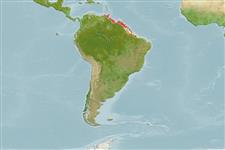Elasmobranchi (squali e razze) (sharks and rays) >
Carcharhiniformes (Ground sharks) >
Carcharhinidae (Requiem sharks)
Etymology: Isogomphodon: iso-, from isos (Gr.), equal; gomphos (Gr.), nail; odon (Gr.), tooth, referring to how teeth are equally fastened, i.e., claviform and straight in both jaws (See ETYFish); oxyrhynchus: oxys (Gr.), sharp; rhynchus (L.), snout, referring to its elongated, pointed and narrow snout [authorship often attributed to Müller & Henle, who published Valenciennes’ description] (See ETYFish).
Environment: milieu / climate zone / depth range / distribution range
Ecologia
marino; salmastro demersale; distribuzione batimetrica ? - 15 m (Ref. 13608). Tropical; 12°N - 20°S, 63°W - 34°W (Ref. 244)
Western Atlantic: Trinidad, Guyana, Suriname, French Guiana, and Brazil.
Length at first maturity / Size / Peso / Age
Maturity: Lm 115.0 range ? - ? cm
Max length : 160 cm TL maschio/sesso non determinato; (Ref. 34266); common length : 100.0 cm TL maschio/sesso non determinato; (Ref. 5217); Età massima riportata: 12 anni (Ref. 34266)
Large number of teeth, great length of very narrow snout. Yellow-gray above and white below (Ref. 6032).
An inshore shark found over rocky bottoms, entering estuaries and river mouths. Feeds on small schooling fishes including herring, anchovies and croakers. Viviparous, generally 4 embryos per brood; size at birth 38 to 41 cm. 244 cm record unconfirmed.
Distinct pairing with embrace (Ref. 205). Viviparous, placental (Ref. 50449).
Compagno, L.J.V., 1984. FAO Species Catalogue. Vol. 4. Sharks of the world. An annotated and illustrated catalogue of shark species known to date. Part 2 - Carcharhiniformes. FAO Fish. Synop. 125(4/2):251-655. Rome: FAO. (Ref. 244)
IUCN Red List Status (Ref. 130435: Version 2024-1)
Human uses
Pesca: pesca di sussistenza
Strumenti
Special reports
Download XML
Fonti Internet
Estimates based on models
Preferred temperature (Ref.
123201): 27 - 27.8, mean 27.5 °C (based on 149 cells).
Phylogenetic diversity index (Ref.
82804): PD
50 = 1.0000 [Uniqueness, from 0.5 = low to 2.0 = high].
Bayesian length-weight: a=0.00490 (0.00229 - 0.01045), b=3.08 (2.91 - 3.25), in cm total length, based on LWR estimates for this (Sub)family-body shape (Ref.
93245).
Trophic level (Ref.
69278): 4.5 ±0.80 se; based on food items.
Generation time: 10.0 ( na - na) years. Estimated as median ln(3)/K based on 2
growth studies.
Resilienza (Ref.
120179): Molto basso, tempo minimo di raddoppiamento della popolazione più di 14 anni (K=0.11-0.12; tm=5-7; tmax=12; Fec=4).
Fishing Vulnerability (Ref.
59153): High to very high vulnerability (74 of 100).
Nutrients (Ref.
124155): Calcium = 25.1 [3.3, 144.5] mg/100g; Iron = 0.725 [0.183, 2.103] mg/100g; Protein = 21.1 [18.8, 23.3] %; Omega3 = 0.16 [0.06, 0.40] g/100g; Selenium = 29.2 [7.9, 91.1] μg/100g; VitaminA = 18.4 [5.8, 57.1] μg/100g; Zinc = 0.728 [0.335, 1.386] mg/100g (wet weight);
